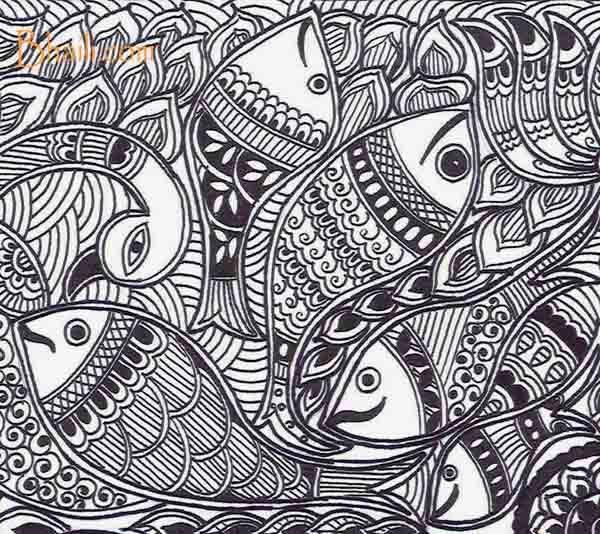
Madhubani Art: A Guide To Create Black and White Madhubani Paintings
Share
This blog was originally written and published by Megha Agarwal for her blog Bhaili.com.
Madhubani painting is a popular Indian folk art originating from Bihar. One of the objectives of this post is to help anyone, who is interested in Madhubani art, create monochrome Madhubani paintings i.e. black and white Madhubani Paintings.
Madhubani painting takes time and needs practice to master. I have not taken any formal training in this art, but learnt by practicing and observing others great artists at work. So, all you need is lots of practice.
Stationary required for black and white Madhubani Painting
- Thick drawing sheet
- Pencil
- Black marker pen
- Fine-tip black pen
- Black poster color
- Fine-tip round brush
- Tracing sheet
Process for black and white Madhubani Painting
- I divided the drawing sheet in four equal parts and sketched a guideline with pencil on one part. Traditionally, skilled Madhubani artists work directly with brush and nib. Their free-flowing hands didn’t required pencil guidelines.
- I then copied the same design on tracing paper and then traced it on all 3 parts. Tracing helped in achieving uniformity in all four parts of the painting.
- After finishing the tracing work with pencil, I proceeded to make the outline with a black marker pen.
- With the fine-tip pen, I made the inner outline. If you notice, there is a double line throughout the painting. Double line is one of the main characteristics of Madhubani Painting.

- With the help of a fine-tip black pen, I did intricate detailing in foreground and background.
- In the last step, I used black poster color and fine-tip round brush to fill in black color.
Fish in Madhubani style
Art gives you lots of liberty to experiment and develop your own style. There are number of ways using which you can make a Madhubani fish. If you observe here I have created five different kinds of fish, each with different detailing.

Background of Madhubani Paintings
I’m often asked what one should observe in Madhubani paintings? My answer is to look for detailing and intricate patterns which make this folk art more treasured.
Even the background plays an important role in Madhubani paintings. No space is left blank. Every inch is filled with fine lines. I have incorporated petal shapes (as shown in image #1) to fill the background. Whereas, to fill small negative space in between I have used the repeated pattern of fine curved lines (as shown in image #2).

Peacock in Madhubani
Initially, I thought of creating a black and white Madhubani fish painting. However, when I started sketching, my love for peacocks couldn’t stop me from drawing Madhubani peacocks.

Role of border in Madhubani painting
The border is essential in Madhubani painting. It gives a complete look to the painting. You can use any repeated pattern of curves to form a border. Here, I have used lotus motifs in all four corners and in the center. I have then completed the border with repeated flowing curve patterns.

So here is the how my completed black and white Madhubani painting looks.

To check out our entire range of name plates inspired by Madhubani art, click here.
